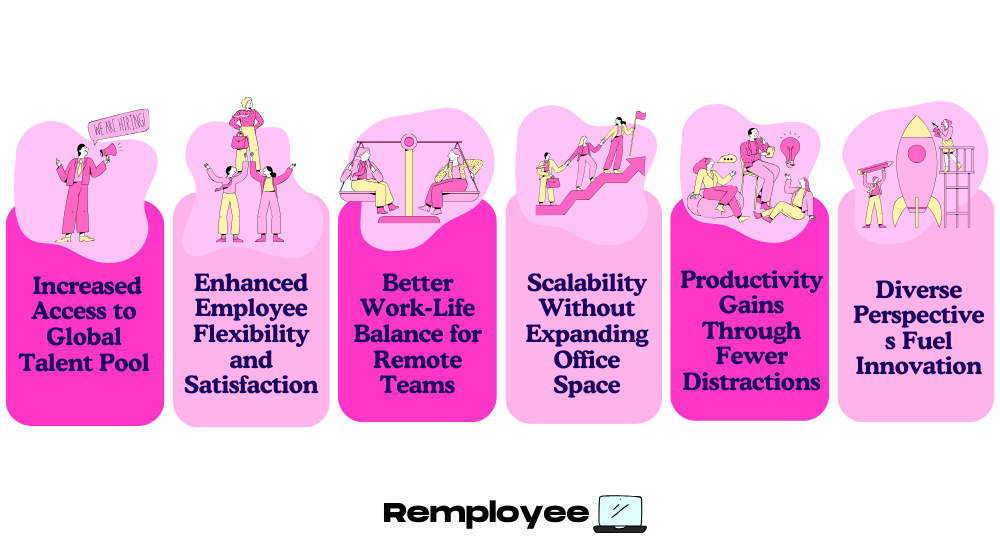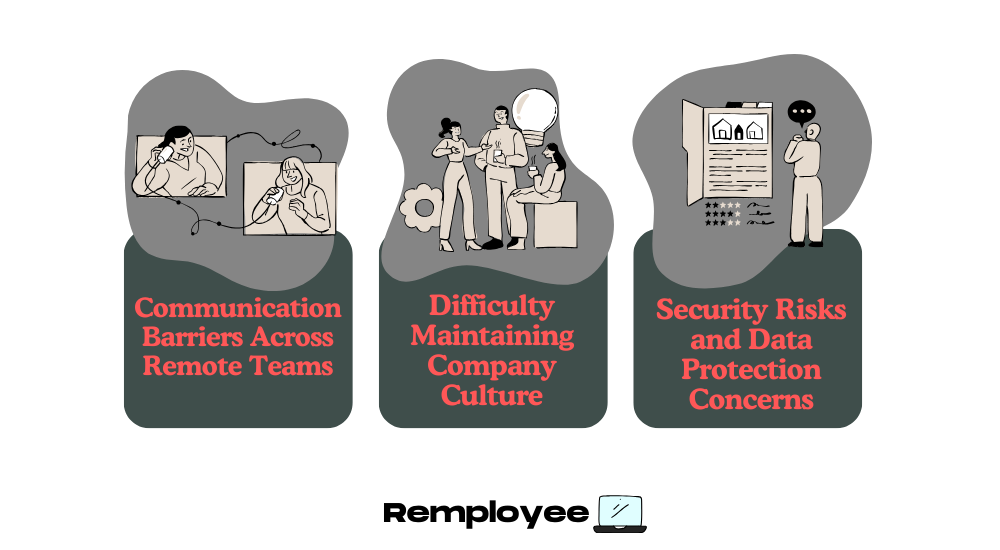The question every HR manager wrestles with today: should we hire remote employees?
The answer impacts more than you might expect.
Remote hiring decisions influence everything from operational budgets to team dynamics and long-term company culture.
Some organizations thrive with distributed teams, while others struggle with virtual collaboration challenges and communication gaps.
The realityis that both remarkable successes and notable failures exist across every industry.
Smart hiring managers need comprehensive insights before making this pivotal decision for their organizations.
Let’s see the biggest pros and cons of hiring remote employees.
Pros of Hiring Remote Employees

1. Increased Access to Global Talent Pool
You’re no longer limited to candidates within commuting distance. Remote hiring expands your talent search from a 30-mile radius to literally anywhere with reliable internet. Companies leveraging remote work report access to 62% more qualified candidates compared to location-restricted hiring.
This matters more than ever. Tech roles, creative positions, specialized expertise—these skills cluster in specific cities. But your perfect marketing strategist might live in Austin while you operate from Detroit. Your ideal developer could be coding from Lisbon while your headquarters sits in Seattle.
The math becomes simple. More candidates means better matches. Better matches mean stronger teams. Stronger teams drive results that actually move the needle.
Geographic boundaries used to dictate hiring decisions. Now they’re irrelevant.
2. Enhanced Employee Flexibility and Satisfaction
Flexibility drives satisfaction, and satisfaction drives retention. Remote employees consistently report higher job satisfaction scores—87% say they feel more connected to their work when given flexibility around where and when they complete tasks.
The reasons stack up fast:
- Zero commute stress or time waste
- Custom work environments tailored to individual preferences
- Schedule control for peak productivity hours
- Location independence for life events or preferences
- Reduced workplace interruptions and politics
This satisfaction translates into measurable business outcomes. Higher retention rates. Lower recruitment costs. Better employer brand reputation. Employees who feel trusted and empowered deliver better work. They stick around longer. They become advocates for your company.
The old model forced people into boxes. Remote work lets them design their ideal professional life.
3. Better Work-Life Balance for Remote Teams
Remote work transforms the exhausting juggle into manageable integration. Parents attend school events. Caregivers support family members. Everyone reclaims commute hours for activities that actually matter.
Workday helps companies track and optimize this balance through automated scheduling features and wellness analytics. Their platform shows remote teams averaging 2.5 more hours weekly for personal activities while maintaining or exceeding productivity targets.
Employees use this time differently. Morning workouts. Lunch with partners. Afternoon school pickups. Evening classes. The rigid 9-to-5 structure dissolves into something more human.
Balance looks different for everyone. Remote work acknowledges this reality and adapts accordingly. The result? Employees who bring their best selves to work because they’re actually living full lives outside it.
4. Scalability Without Expanding Office Space
Growing companies hit the space wall eventually. More employees means more desks, bigger offices, longer leases. Remote hiring eliminates this expensive bottleneck entirely.
Traditional scaling versus remote scaling tells the story:
Startups scale from 5 to 50 employees without signing crushing real estate contracts. Established companies expand into new markets without satellite offices. Seasonal businesses ramp up and down without penalty.
Physical constraints vanish. Growth happens at the speed of hiring, period.
5. Productivity Gains Through Fewer Distractions
Open offices killed productivity. Remote work brought it back. Stanford research shows remote workers are 13% more productive than their office counterparts, completing nearly a full extra day of work each week.
The productivity boost comes from eliminating office theater. No mandatory birthday celebrations. No drive-by meetings. No Karen from accounting discussing her weekend plans at maximum volume. Remote employees control their environment, optimize their setup, and actually focus.
Deep work becomes possible again. Complex problems get solved. Creative projects reach completion. The constant interruption cycle that plagues modern offices simply disappears.
Some worry remote workers slack off. Data proves the opposite. They work more focused hours and deliver better results.
6. Diverse Perspectives Fuel Innovation
Homogeneous teams create homogeneous solutions. An inclusive remote workspace breaks this pattern by bringing together people from different cities, cultures, backgrounds, and life experiences.
Geographic diversity creates cognitive diversity. Your product team includes perspectives from rural Montana and downtown Mumbai. Marketing campaigns reflect insights from multiple markets simultaneously. Customer service understands regional differences intuitively because the team lives them daily.
This diversity drives measurable innovation. Mixed teams solve problems faster, spot opportunities others miss, and create products that resonate across demographics. They challenge assumptions because they literally see the world differently.
Innovation requires friction between different viewpoints. Remote teams deliver this naturally.
Cons of Hiring Remote Employees

1. Communication Barriers Across Remote Teams
Remote communication breaks down faster than you think. Time zones create response delays. Context gets lost in translation. Quick clarifications turn into lengthy email chains.
The friction points multiply:
- Asynchronous messages lack tone and nuance
- Video fatigue from endless virtual meetings
- Important discussions happen in scattered channels
- Casual conversations that spark ideas vanish
- Technical issues disrupt critical discussions
- Different communication preferences clash constantly
These barriers compound daily. A simple question takes hours instead of seconds. Misunderstandings escalate before anyone notices. Team members feel isolated despite constant digital contact.
The spontaneous problem-solving that happens naturally in offices requires deliberate orchestration remotely. Some teams master this dance. Many struggle indefinitely. The communication overhead becomes a hidden tax on every project, every decision, every relationship.
2. Difficulty Maintaining Company Culture
Culture dies in isolation. Buffer’s 2023 State of Remote Work report found 23% of remote workers struggle with loneliness, directly impacting their connection to company values and mission.
Virtual happy hours feel forced. Slack celebrations ring hollow. New employees onboard without absorbing the unwritten rules that define how work actually gets done. Veterans drift away from core values without daily reinforcement.
The intangibles that create belonging—random coffee conversations, shared struggles, spontaneous celebrations—evaporate in distributed settings. Culture becomes a PowerPoint deck instead of lived experience.
Some companies crack the code through intentional rituals, regular retreats, and creative team building ideas.
Most watch their carefully cultivated culture slowly dilute into generic corporate speak. The magic that attracted talent initially fades into memory.
3. Security Risks and Data Protection Concerns
Security Risks and Data Protection Concerns
Every remote employee represents a potential security breach. Home networks, coffee shop WiFi, personal devices—each connection point creates vulnerability.
According to IBM’s Cost of a Data Breach Report, remote work increased breach costs by $1.07 million compared to fully on-site environments. The exposure points multiply exponentially.
Consider the attack surfaces:
Remote work blurs boundaries between personal and professional digital lives. Employees access sensitive data from unmonitored locations. Physical document security becomes impossible to track. Intellectual property walks out virtual doors without detection.
The infrastructure needed for proper security costs serious money and demands constant vigilance. Understanding your employer obligations for remote employees becomes critical to maintaining compliance and protecting both your business and workers. One phishing email, one weak password, one lost laptop could expose everything.
The Remote Hiring Decision
Remote work changed everything… and there’s no going back.
The benefits stack up fast: global talent, slashed costs, happier employees. But the challenges are not that insignificant too: communication chaos, fading culture, security headaches.
Anyway, companies thriving with remote teams didn’t get lucky. They got intentional. They built systems. Invested in culture. Protected their data.
The question facing you now? Will you commit to making remote work actually work, or keep wondering what could have been?
Your competitors already decided.
Ben doesn’t buy into “the way it’s always been done.” He’s spent his career challenging hiring norms and rethinking how remote work should feel. At Remployee, he helps create honest tools and opportunities for people tired of the gig economy’s empty promises.



